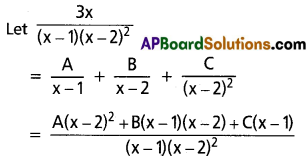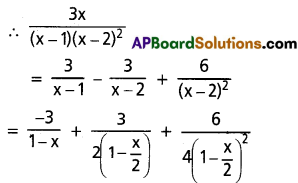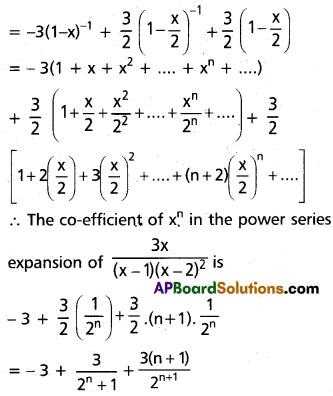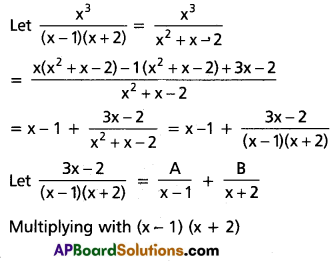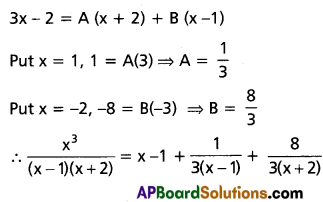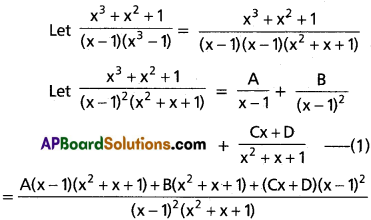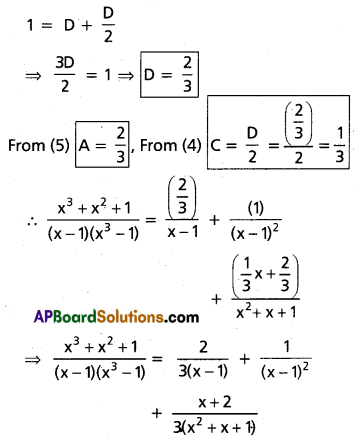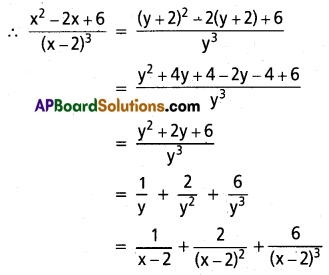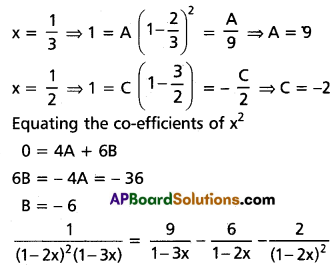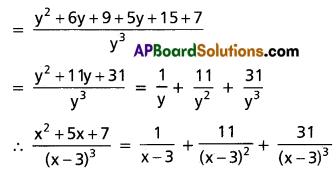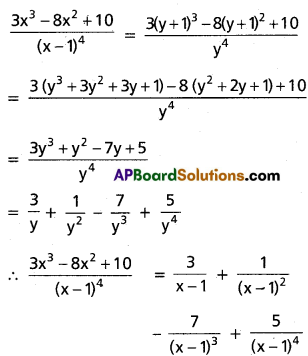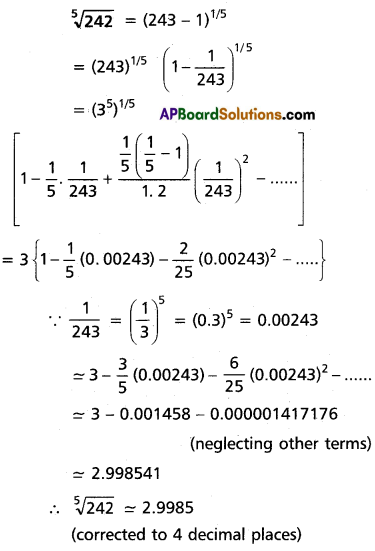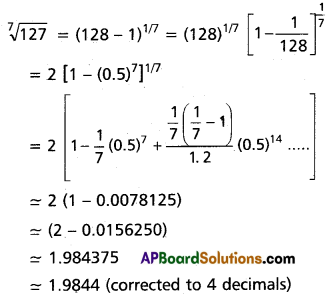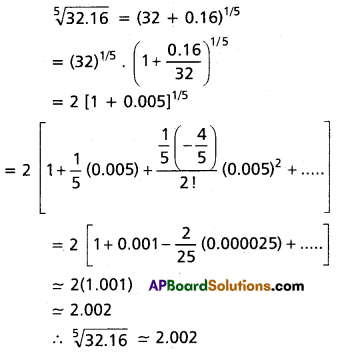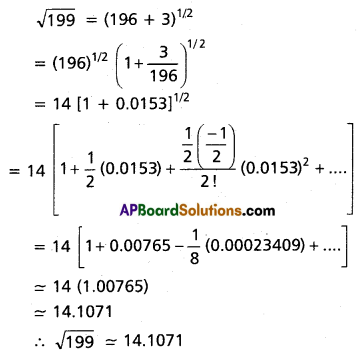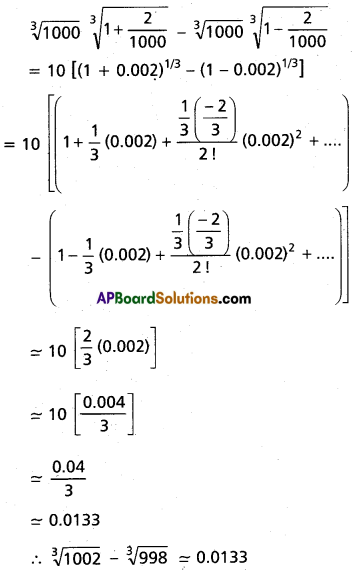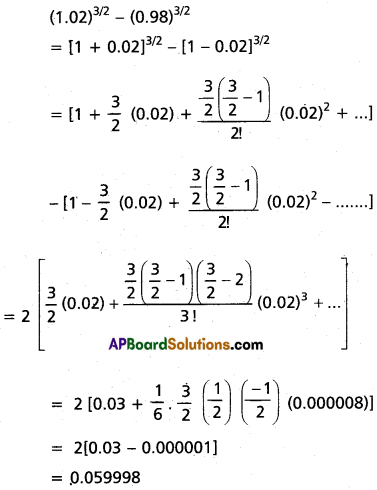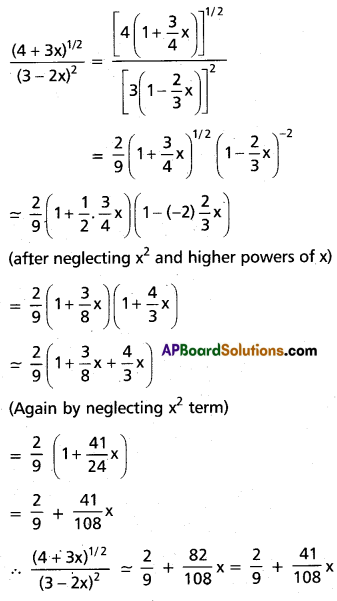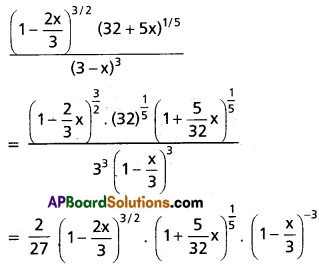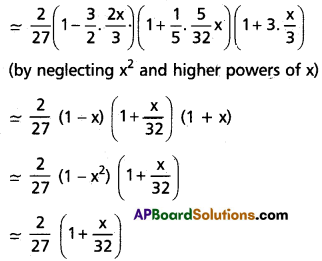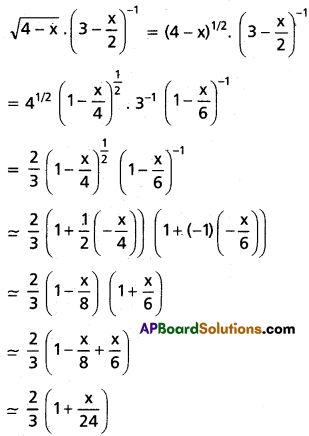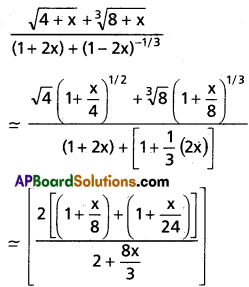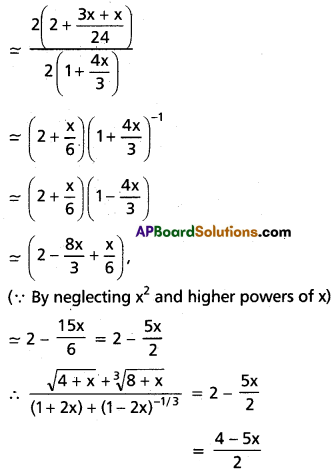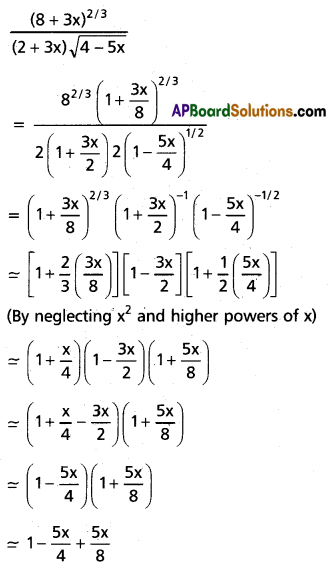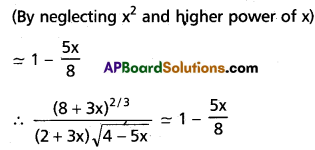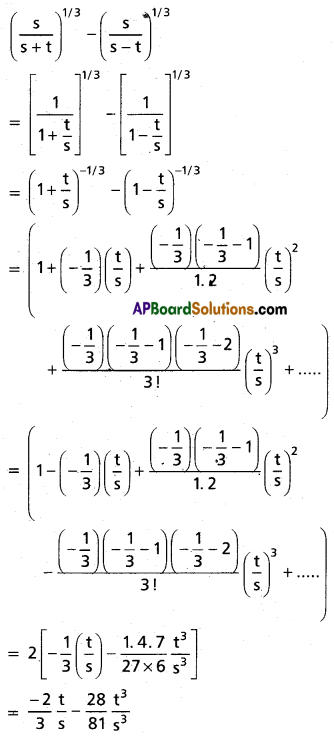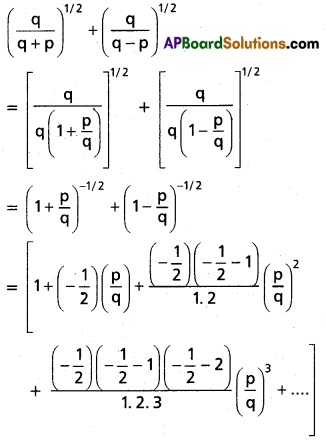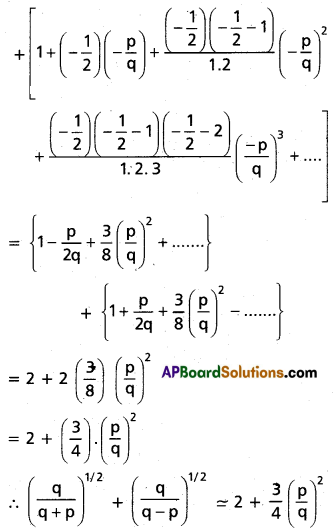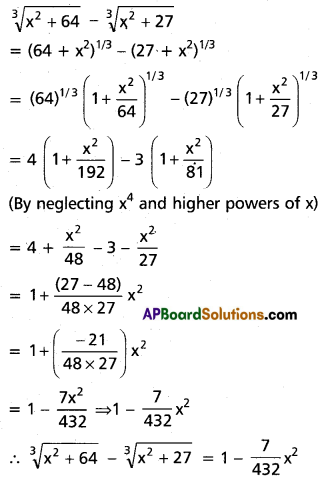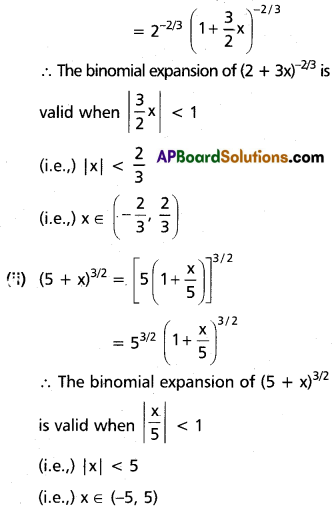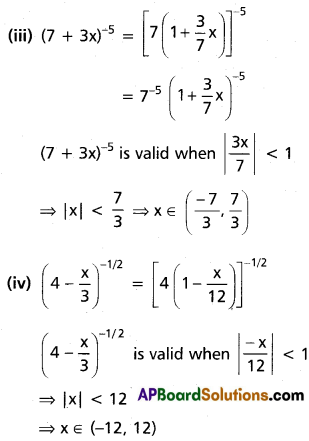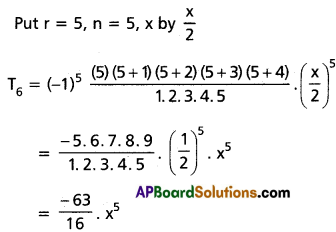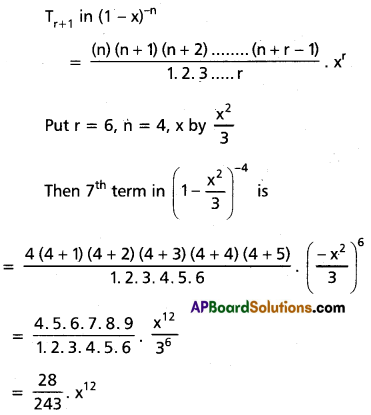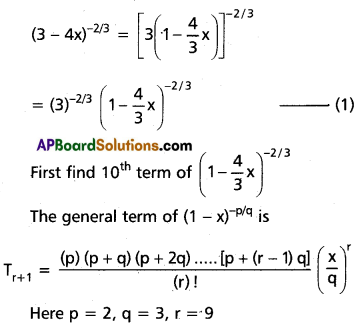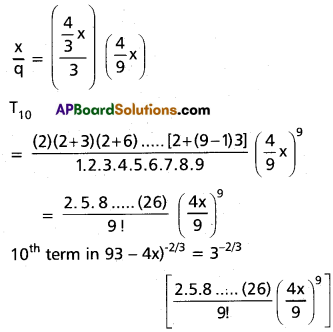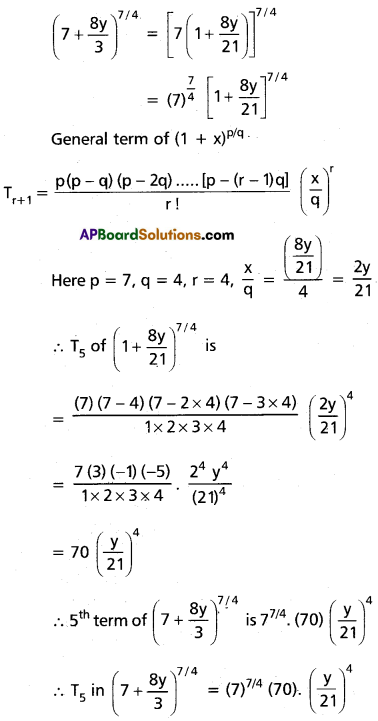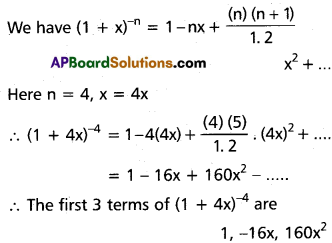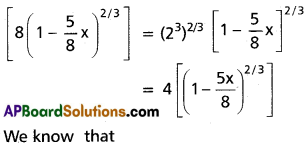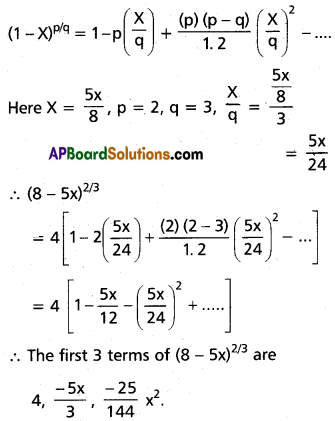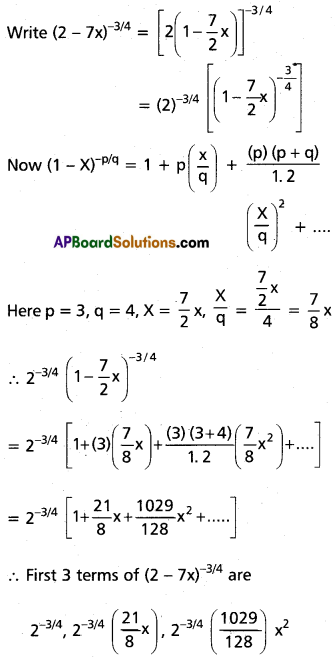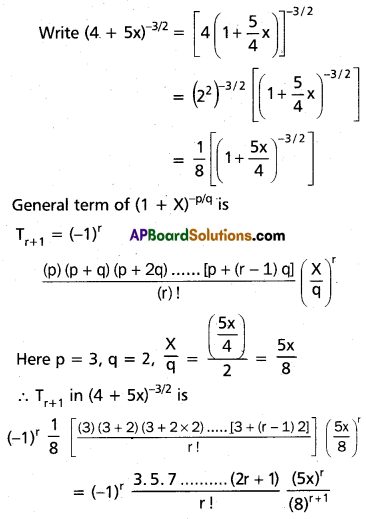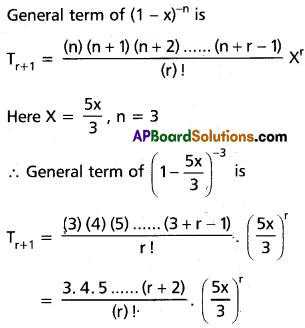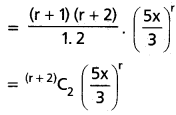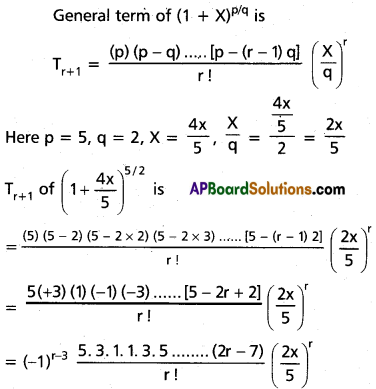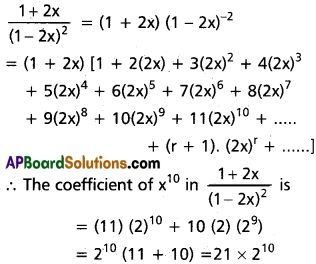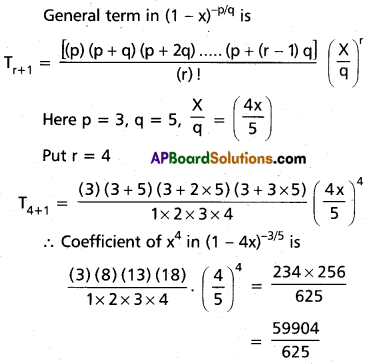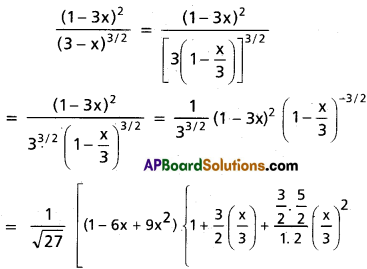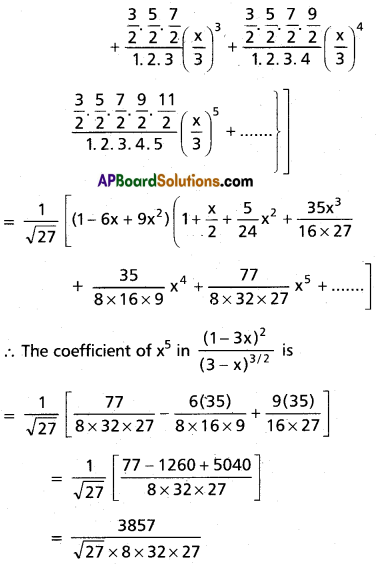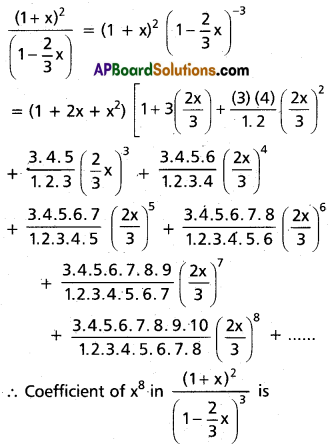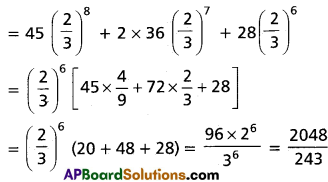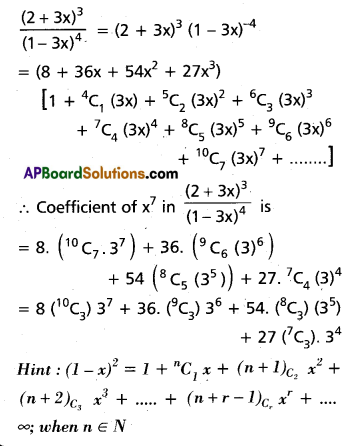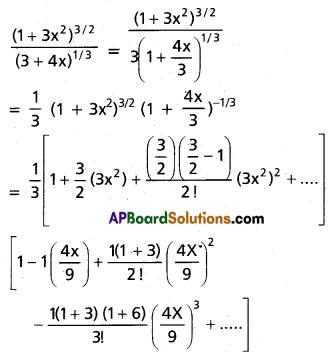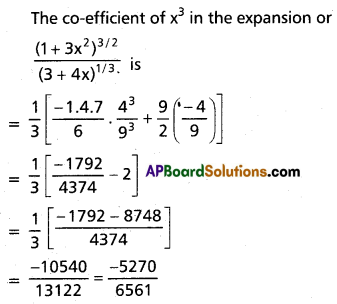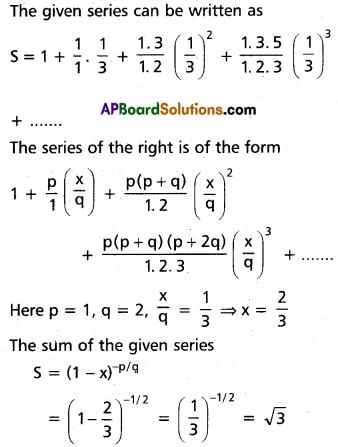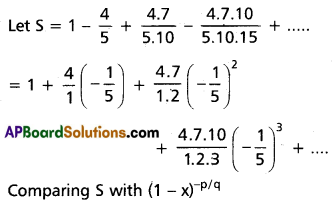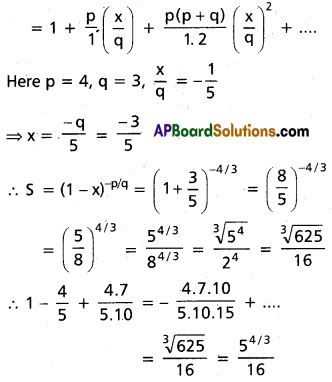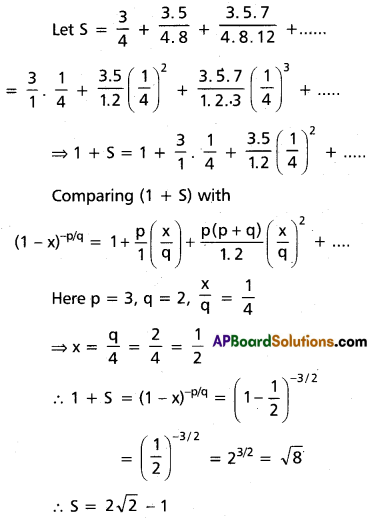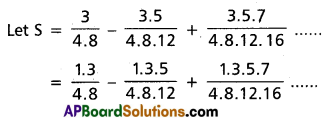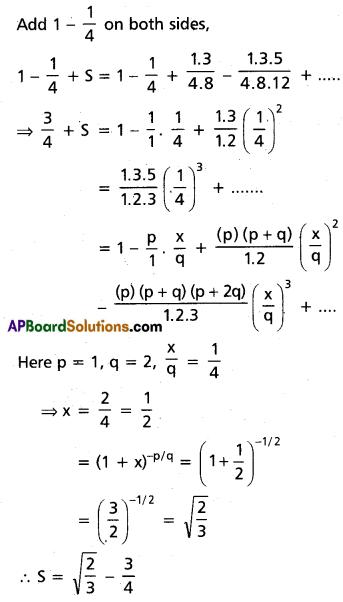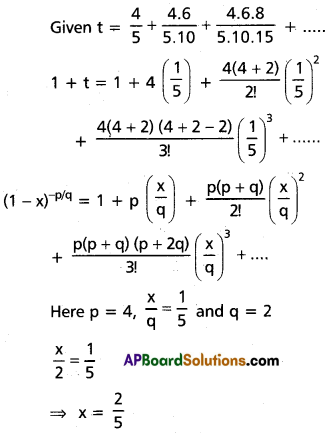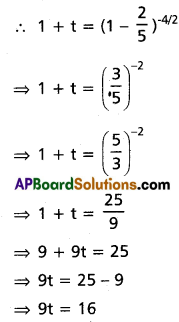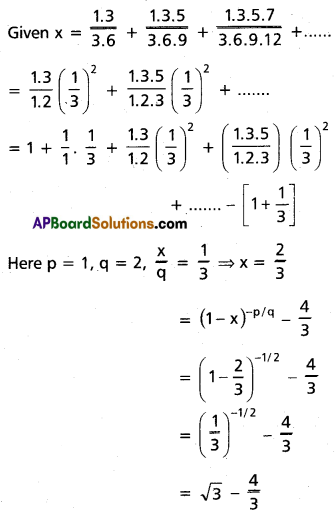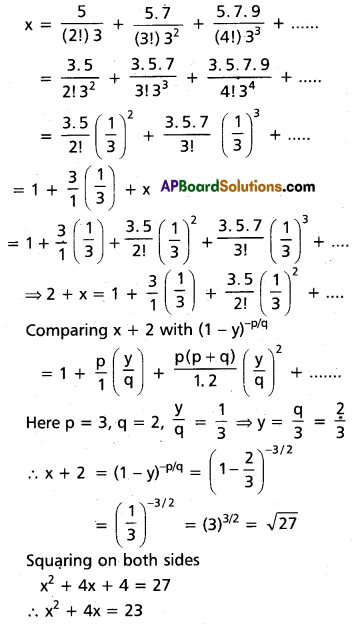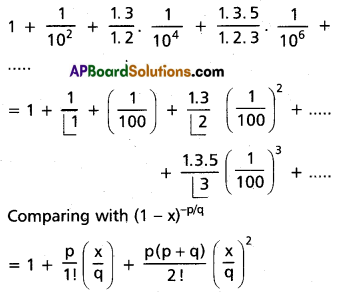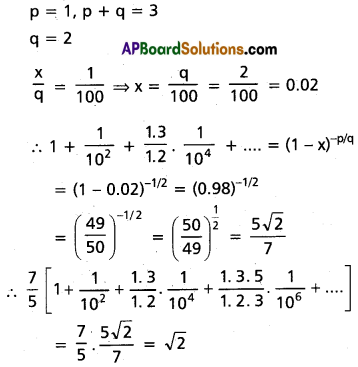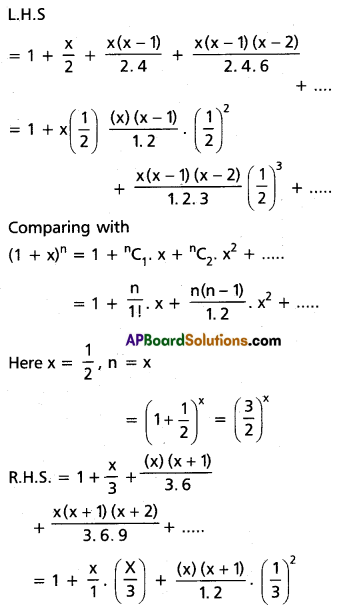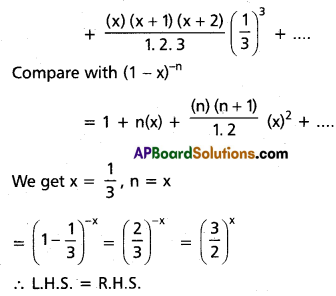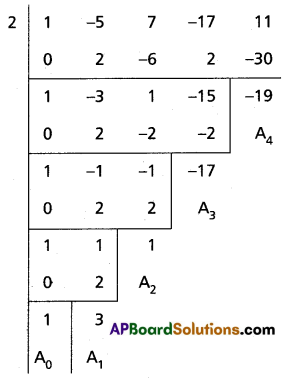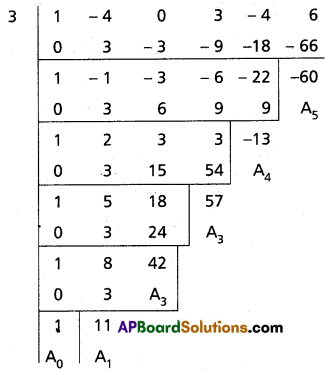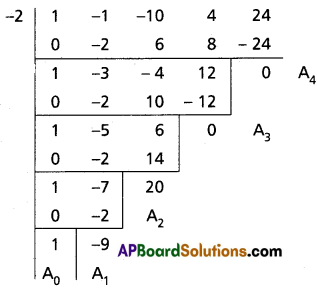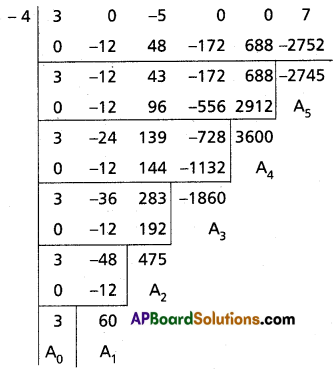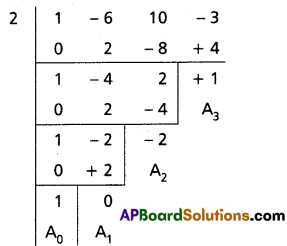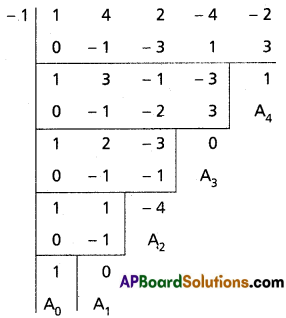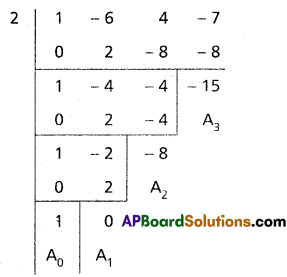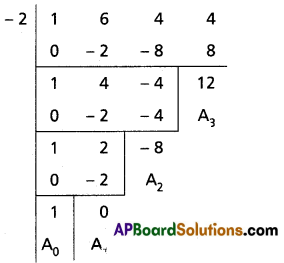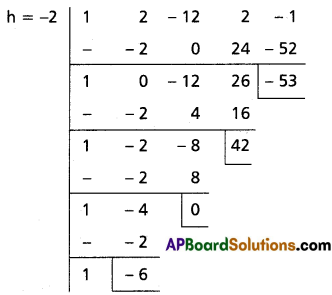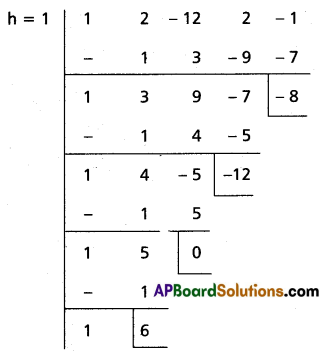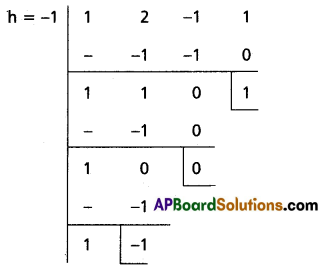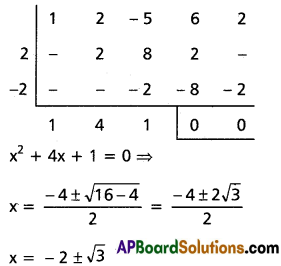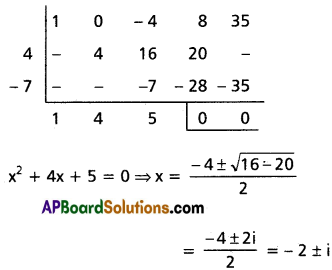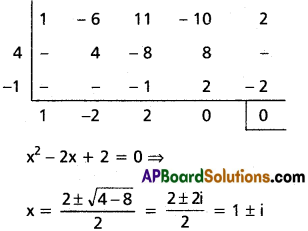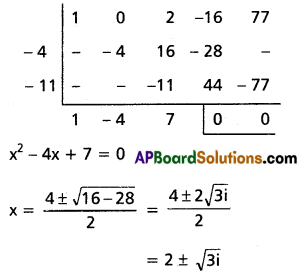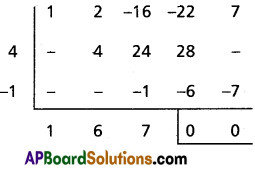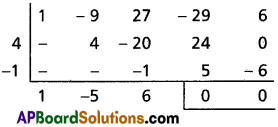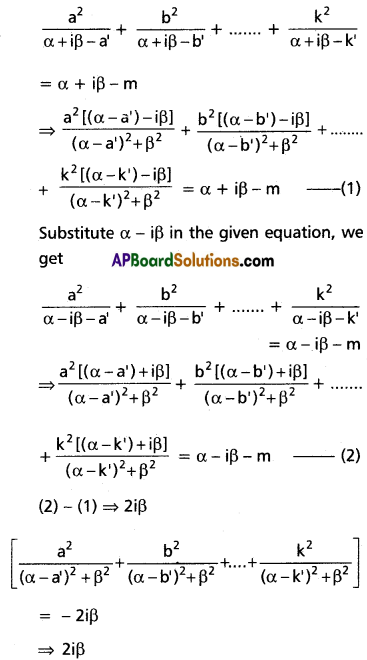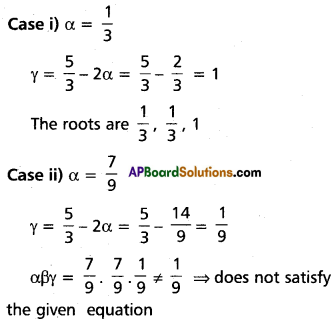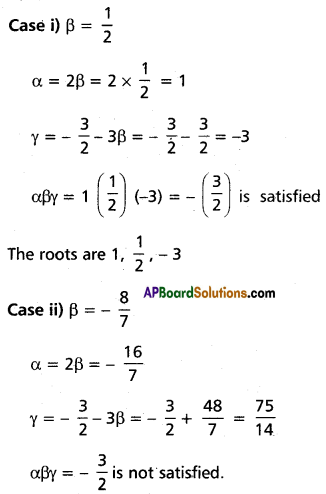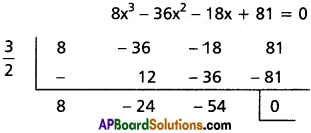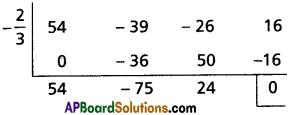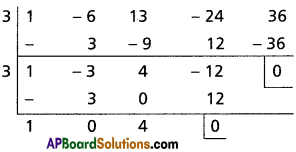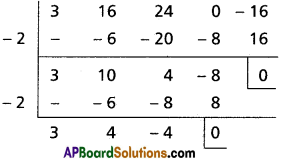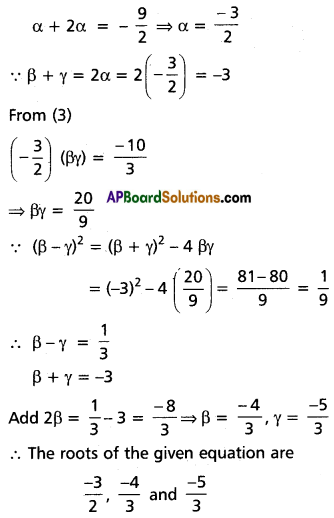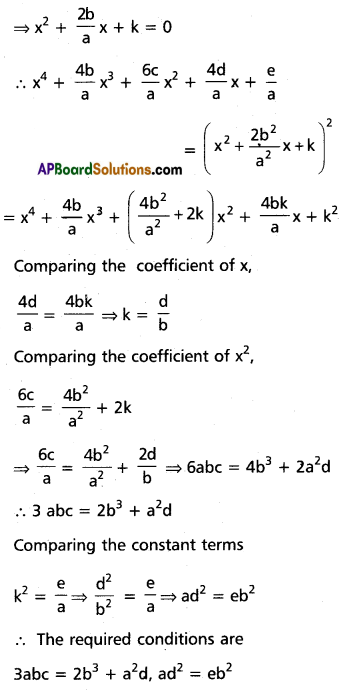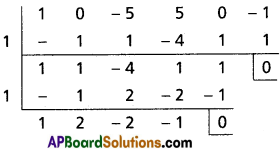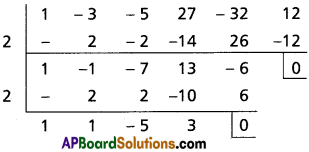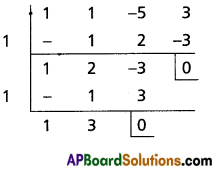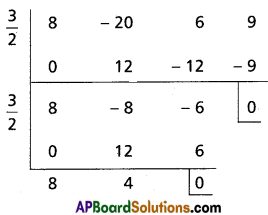Practicing the Intermediate 2nd Year Maths 2A Textbook Solutions Inter 2nd Year Maths 2A Binomial Theorem Solutions Exercise 6(a) will help students to clear their doubts quickly.
Intermediate 2nd Year Maths 2A Binomial Theorem Solutions Exercise 6(a)
I.
Question 1.
Expand the following using the binomial theorem.
(i) (4x + 5y)7
Solution:
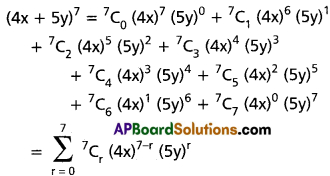
(ii) \(\left(\frac{2}{3} x+\frac{7}{4} y\right)^5\)
Solution:
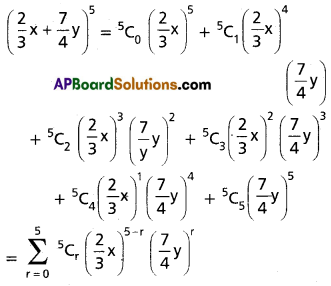
(iii) \(\left(\frac{2 p}{5}-\frac{3 q}{7}\right)^6\)
Solution:
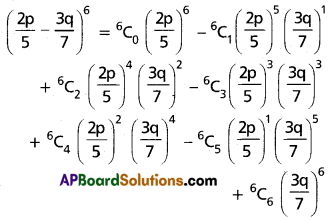
\(\sum_{r=0}^6(-1)^{r \cdot 6} C_r\left(\frac{2 p}{5}\right)^{6-r}\left(\frac{3 q}{7}\right)^r\)
(iv) (3 + x – x2)4
Solution:
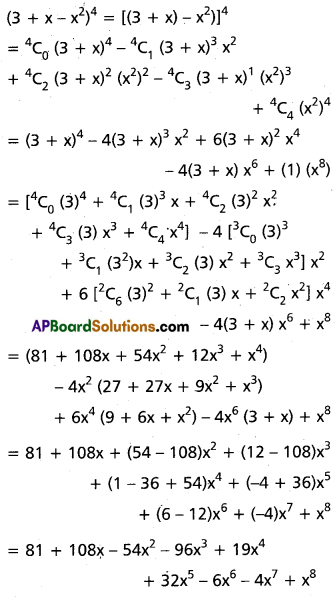

Question 2.
Write down and simplify
(i) 6th term in \(\left(\frac{2 x}{3}+\frac{3 y}{2}\right)^9\)
Solution:
6th term in \(\left(\frac{2 x}{3}+\frac{3 y}{2}\right)^9\)
The general term in \(\left(\frac{2 x}{3}+\frac{3 y}{2}\right)^9\) is
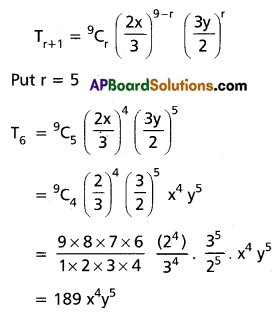
(ii) 7th term in (3x – 4y)10
Solution:
7th term in (3x – 4y)10
The general term in (3x – 4y)10 is
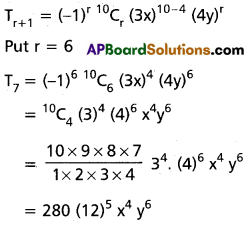
(iii) 10th term in \(\left(\frac{3 p}{4}-5 q\right)^{14}\)
Solution:
10th term in \(\left(\frac{3 p}{4}-5 q\right)^{14}\)
General term in \(\left(\frac{3 p}{4}-5 q\right)^{14}\) is
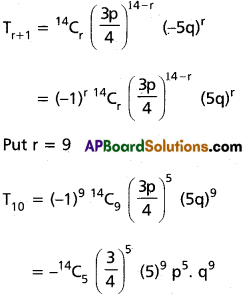
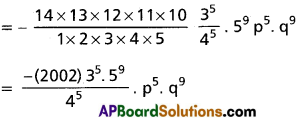
(iv) rth term in \(\left(\frac{3 a}{5}+\frac{5 b}{7}\right)^8\) (1 ≤ r ≤ 9)
Solution:
rth term in \(\left(\frac{3 a}{5}+\frac{5 b}{7}\right)^8\)
The general term in \(\left(\frac{3 a}{5}+\frac{5 b}{7}\right)^8\) is
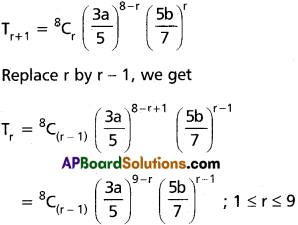
Question 3.
Find the number of terms in the expansion of
(i) \(\left(\frac{3 a}{4}+\frac{b}{2}\right)^9\)
Solution:
The number of terms in (x + a)n is (n + 1), where n is a positive integer.
Hence number of terms in \(\left(\frac{3 a}{4}+\frac{b}{2}\right)^9\) are 9 + 1 = 10
(ii) (3p + 4q)14
Solution:
Number of terms in (3p + 4q)14 are 14 + 1 = 15
(iii) (2x + 3y + z)7
Solution:
Number of terms in (a + b + c)n are \(\frac{(n+1)(n+2)}{2}\), where n is a positive integer.
Hence number of terms in (2x + 3y + z)7 are = \(\frac{(7+1)(7+2)}{2}=\frac{8 \times 9}{2}\) = 36

Question 4.
Find the number of terms with non-zero coefficients in (4x – 7y)49 + (4x + 7y)49.
Solution:

∴ The number of terms with non-zero coefficient in (4x – 7y)49 + (4x + 7y)49 is 25.
Question 5.
Find the sum of the last 20 coefficients in the expansions of (1 + x)39.
Solution:
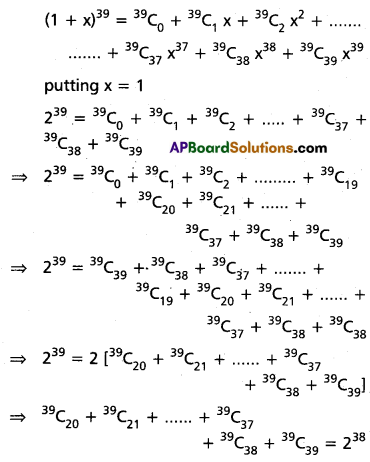
∴ The sum of the last 20 coefficients in the expansion of (1 + x)39 is 238.
Question 6.
If A and B are coefficients of xn in the expansion of (1 + x)2n and (1 + x)2n-1 respectively, then find the value of \(\frac{A}{B}\)
Solution:
Given A and B are the coefficient of xn in the expansion of (1 + x)2n and (1 + x)2n-1 respectively.
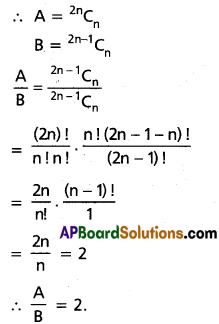
II.
Question 1.
Find the coefficient of
(i) x-6 in \(\left(3 x-\frac{4}{x}\right)^{10}\)
Solution:

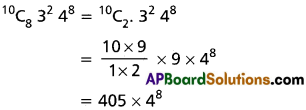
(ii) x11 in \(\left(2 x^2+\frac{3}{x^3}\right)^{13}\)
Solution:
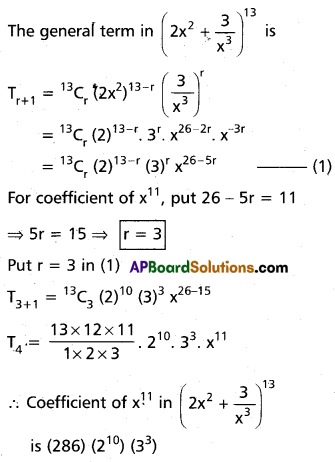
(iii) x2 in \(\left(7 x^3-\frac{2}{x^2}\right)^9\)
Solution:
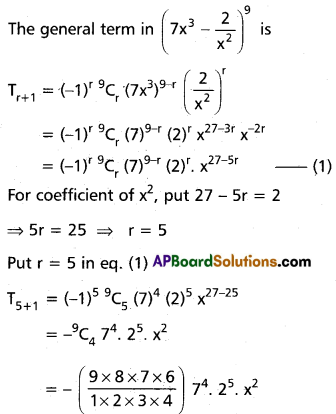

(iv) x-7 in \(\left(\frac{2 x^2}{3}-\frac{5}{4 x^5}\right)^7\)
Solution:
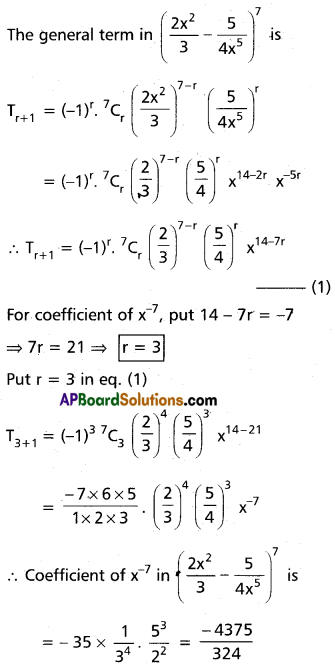
Question 2.
Find the term independent of x in the expansion of
(i) \(\left(\frac{\sqrt{x}}{3}-\frac{4}{x^2}\right)^{10}\)
Solution:
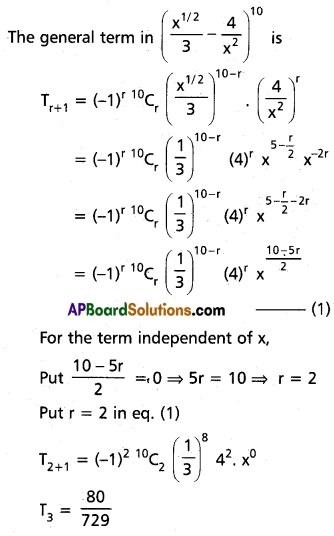
(ii) \(\left(\frac{3}{\sqrt[3]{x}}+5 \sqrt{x}\right)^{25}\)
Solution:
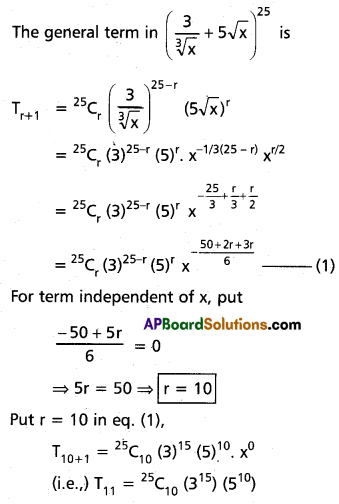
(iii) \(\left(4 x^3+\frac{7}{x^2}\right)^{14}\)
Solution:
The general term in \(\left(4 x^3+\frac{7}{x^2}\right)^{14}\) is
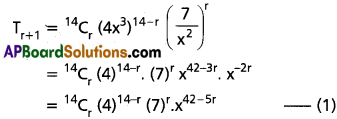
For term independent of x,
put 42 – 5r = 0
⇒ r = \(\frac{42}{5}\) which is not an integer.
Hence term independent of x in the given expansion is zero.
(iv) \(\left(\frac{2 x^2}{5}+\frac{15}{4 x}\right)^9\)
Solution:
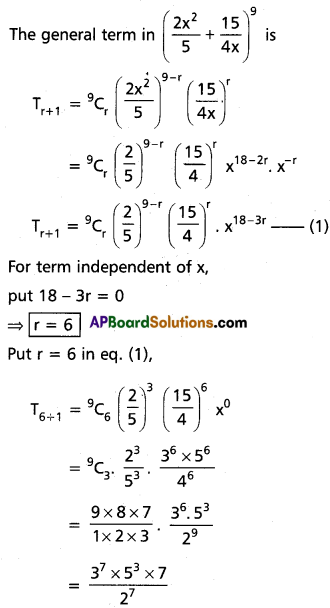

Question 3.
Find the middle term(s) in the expansion of
(i) \(\left(\frac{3 x}{7}-2 y\right)^{10}\)
Solution:
The middle term in (x + a)n when n is even and is \(\frac{T_{n+1}}{2}\), when n is odd, we have two middle terms, i.e., \(\frac{T_{n+1}}{2}\) and \(\frac{T_{n+3}}{2}\)
∵ n = 10 is even,
we have only one middle term (i.e.,) \(\frac{10}{2}\) + 1 = 6th term.
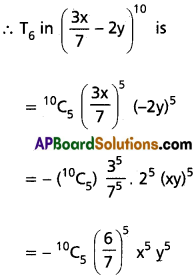
(ii) \(\left(4 a+\frac{3}{2} b\right)^{11}\)
Solution:
Here n = 11 is an odd integer,
we have two middle terms, i.e., \(\frac{n+1}{2}\) and \(\frac{n+3}{2}\) terms
= 6th and 7th terms are middle terms.
T6 in \(\left(4 a+\frac{3}{2} b\right)^{11}\) is \({ }^{11} C_5(4 a)^6\left(\frac{3}{2} b\right)^5\)
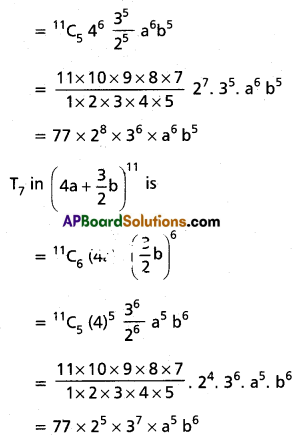
(iii) (4x2 + 5x3)17
Solution:
(4x2 + 5x3)17 = [x2(4 + 5x)]17 = x34(4 + 5x)17 ……..(1)
Consider (4 + 5x)17
∵ n = 17 is an odd positive integer, we have two middle terms.
They are \(\left(\frac{17+1}{2}\right)^{\text {th }}\) and \(\left(\frac{17+3}{2}\right)^{\text {th }}\) (i.e.,) 9th and 10th terms are middle terms.
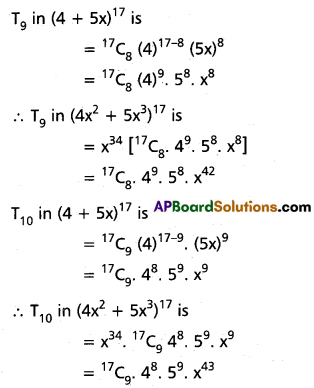
(iv) \(\left(\frac{3}{a^3}+5 a^4\right)^{20}\)
Solution:
Here n = 20 is an even positive integer, we have only one middle term
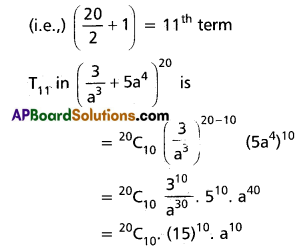
Question 4.
Find the numerically greatest term(s) in the expansion of
(i) (4 + 3x)15 when x = \(\frac{7}{2}\)
Solution:

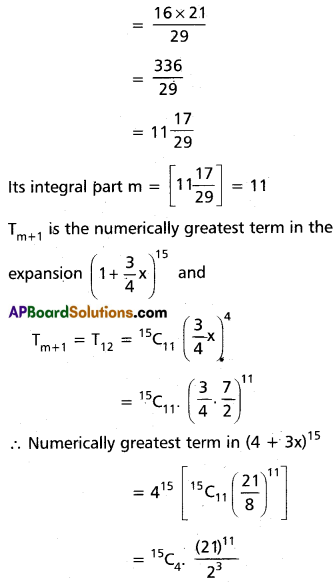
(ii) (3x + 5y)12 when x = \(\frac{1}{2}\), y = \(\frac{4}{3}\)
Solution:

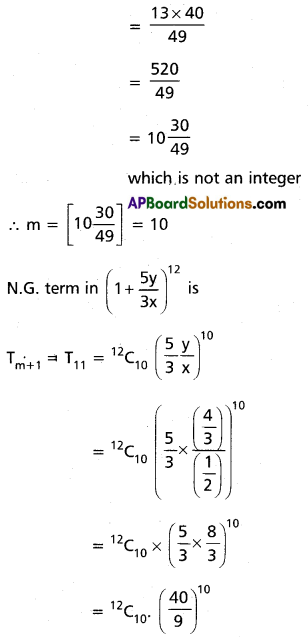
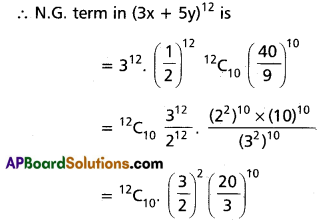
(iii) (4a – 6b)13 when a = 3, b = 5
Solution:
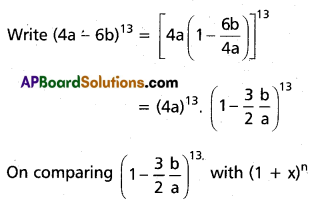
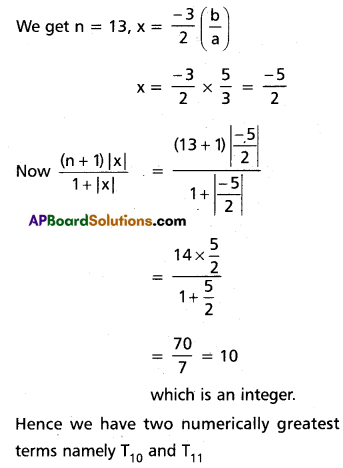
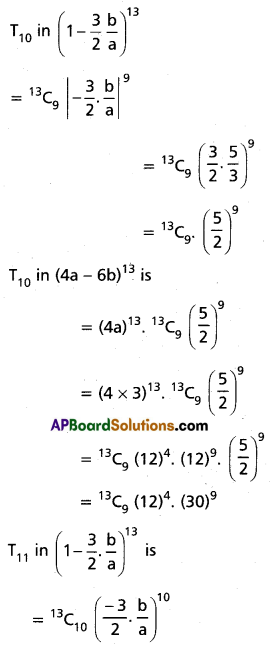
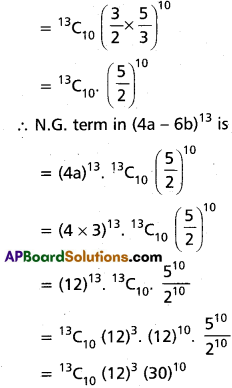
(iv) (3 + 7x)n when x = \(\frac{4}{5}\), n = 15
Solution:
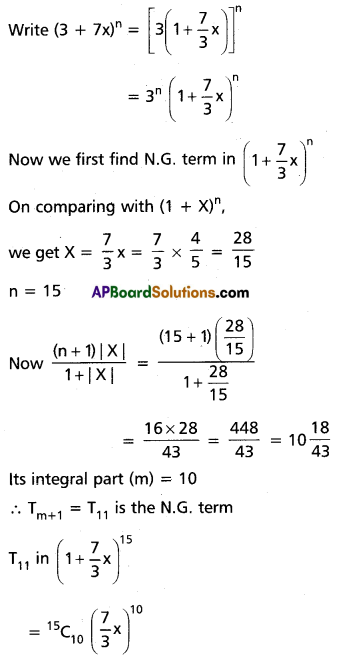
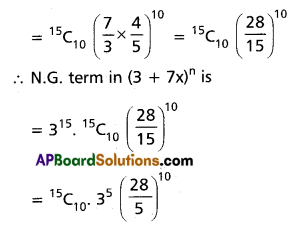

Question 5.
Prove the following.
(i) 2 . C0 + 5 . C1 + 8 . C2 + ……… + (3n+2) . Cn = (3n + 4) . 2n-1
Solution:
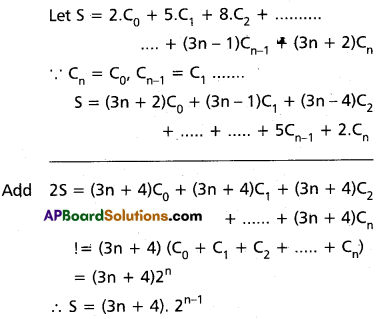
(ii) C0 – 4 . C1 + 7 . C2 – 10 . C3 + ……… = 0, if n is an even positive integer.
Solution:
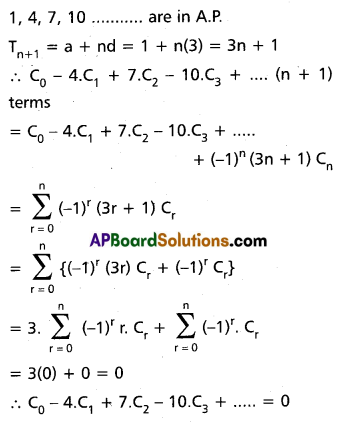
(iii) \(\frac{C_1}{2}+\frac{C_3}{4}+\frac{C_5}{6}+\frac{C_7}{8}+\ldots \ldots=\frac{2^n-1}{n+1}\)
Solution:
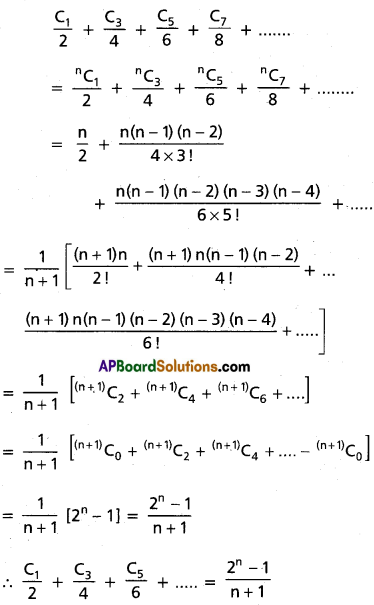
(iv) \(C_0+\frac{3}{2} \cdot C_1+\frac{9}{3} \cdot C_2+\frac{27}{4} \cdot C_3\) + ……… + \(\frac{3^n}{n+1} \cdot C_n=\frac{4^{n+1}-1}{3(n+1)}\)
Solution:
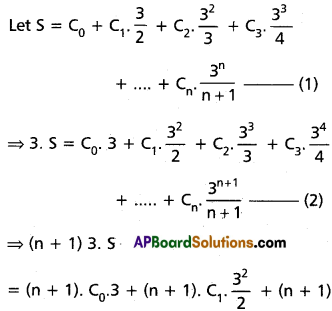
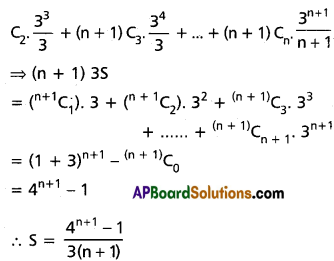
(v) C0 + 2 . C1 + 4 . C2 + 8 . C3 + ….. + 2n . Cn = 3n
Solution:
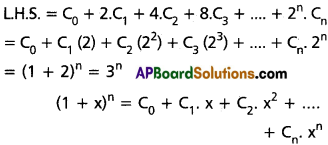
Question 6.
Find the sum of the following.
(i) \(\frac{{ }^{15} C_1}{{ }^{15} C_0}+2 \frac{{ }^{15} C_2}{{ }^{15} C_1}+3 \frac{{ }^{15} C_3}{{ }^{15} C_2}\) + …….. + \(15 \frac{{ }^{15} C_{15}}{{ }^{15} C_{14}}\)
Solution:
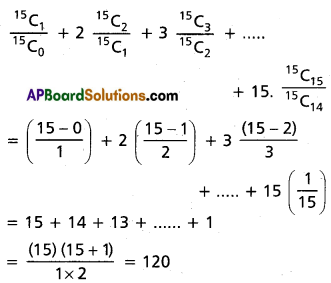
(ii) C0 . C3 + C1 . C4 + C2 . C5 + …….. + Cn-3 . Cn
Solution:
We know that
(1 + x)n = C0 + C1 x + C2 x2 + ……. + Cn . xn ……….(1)
On replacing x by \(\frac{1}{x}\), we get
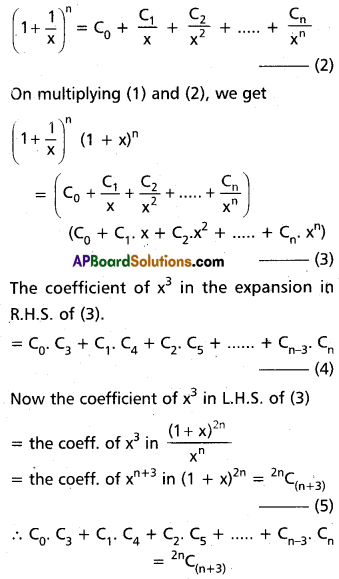
(iii) 22 . C0 + 32 . C1 + 42 . C2 + ……… + (n + 2)2 Cn
Solution:
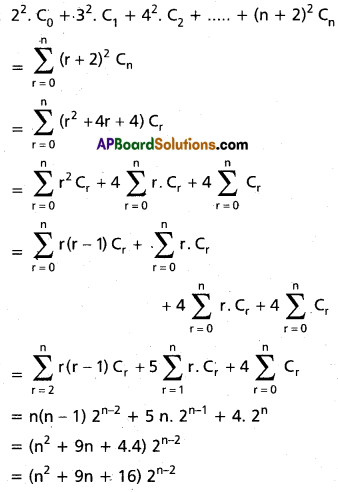
(iv) 3C0 + 6C1 + 12C2 + ……… + 3 . 2n . Cn
Solution:
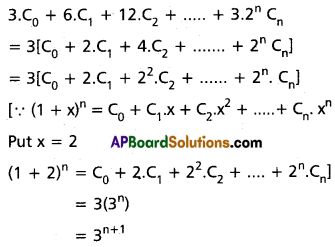
Question 7.
Using the binomial theorem, prove that 50n – 49n – 1 is divisible by 492 for all positive integers n.
Solution:
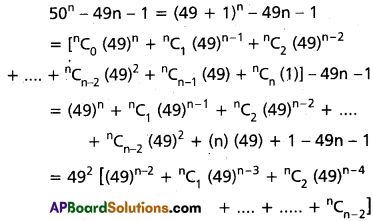
= 492 [a positive integer]
Hence 50n – 49n – 1 is divisible by 492 for all positive integers of n.
Question 8.
Using the binomial theorem, prove that 54n + 52n – 1 is divisible by 676 for all positive integers n.
Solution:
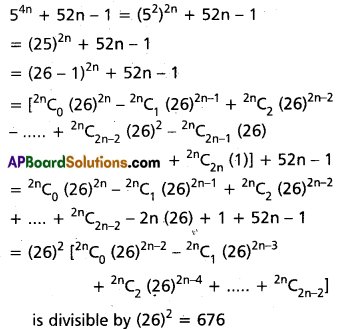
∴ 54n + 52n – 1 is divisible by 676, for all positive integers n.

Question 9.
If (1 + x + x2)n = a0 + a1 x + a2 x2 + ……… + a2n x2n, then prove that
(i) a0 + a1 + a2 + ……… + a2n = 3n
(ii) a0 + a2 + a4 + …… + a2n = \(\frac{3^n+1}{2}\)
(iii) a1 + a3 + a5 + ……… + a2n-1 = \(\frac{3^n-1}{2}\)
(iv) a0 + a3 + a6 + a9 + ……….. = 3n-1
Solution:
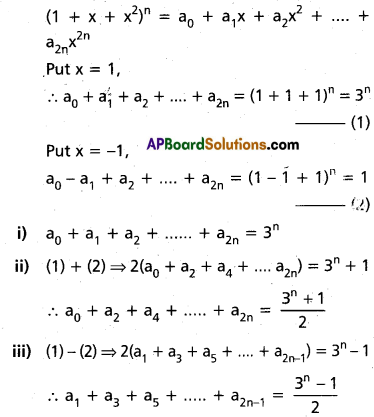
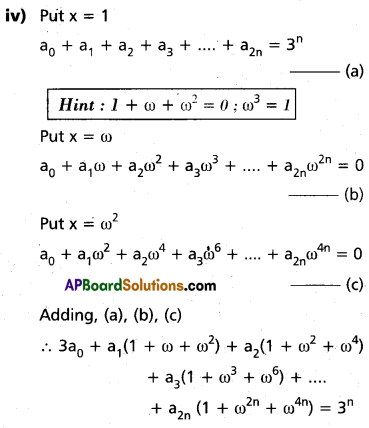

Question 10.
If (1 + x + x2 + x3)7 = b0 + b1x + b2x2 + ………. b21 x21, then find the value of
(i) b0 + b2 + b4 + …….. + b20
(ii) b1 + b3 + b5 + ………. + b21
Solution:
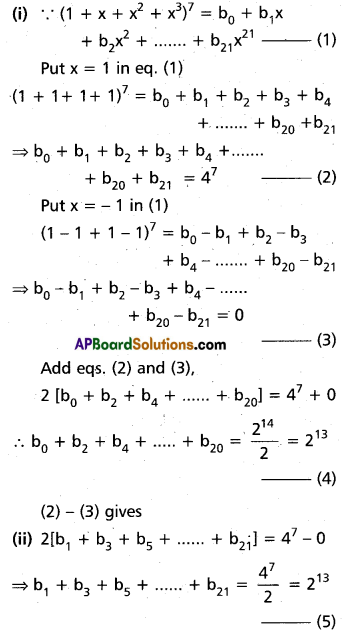
Question 11.
If the coefficient of x11 and x12 in the binomial expansion of \(\left(2+\frac{8 x}{3}\right)^n\) are equal, find n.
Solution:
The general term of \(\left(2+\frac{8 x}{3}\right)^n\) is \(T_{r+1}={ }^n C_r(2)^{n-r}\left(\frac{8 x}{3}\right)^r\)
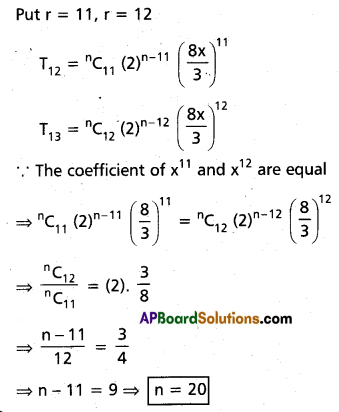
Question 12.
Find the remainder when 22013 is divided by 17.
Solution:
We know 24 = 16
The remainder when 24 is divided by 17 is 1
22013 = (24)503 . 21
∴ The remainder when 22013 is divided by 17 is (-1)503 . 2 = (-1) . 2 = -2
Question 13.
If the coefficients of (2r + 4)th term and (3r + 4)th term in the expansion of (1 + x)21 are equal, find r.
Solution:
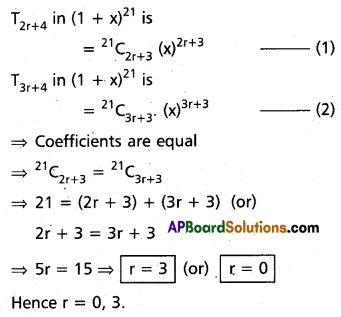
III.
Question 1.
If the coefficients of x9, x10, x11 in the expansion of (1 + x)n are in A.P., then prove that n2 – 41n + 398 = 0.
Solution:
The coefficients of x9, x10, x11 in (1 + x)n are
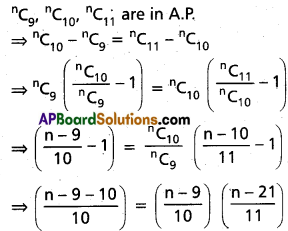
⇒ (n – 9) (n – 21) = 11(n – 19)
⇒ n2 – 9n – 21n + 189 = 11n – 209
⇒ n2 – 41n + 398 = 0

Question 2.
If 36, 84, 126 are three successive binomial coefficients in the expansion of (1 + x)n, find n.
Solution:
Let nCr-1, nCr, nCr+1 are three successive binomial coefficients in (1 + x)n.
Then nCr-1 = 36; nCr = 84 and nCr+1 = 126
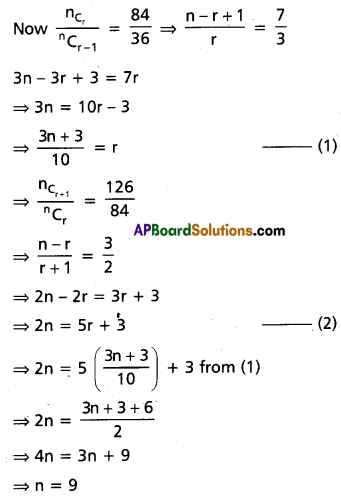
Question 3.
If the 2nd, 3rd and 4th terms in the expansion of (a + x)n are respectively 240, 720, 1080, find a, x, n.
Solution:
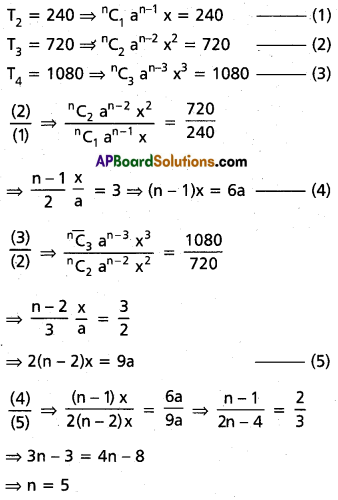
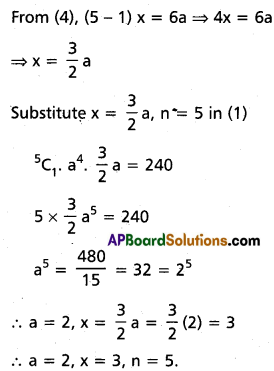
Question 4.
If the coefficients of rth, (r + 1)th and (r + 2)nd terms in the expansion of (1 + x)n are in A.P. then show that n2 – (4r + 1)n + 4r2 – 2 = 0.
Solution:
Coefficient of Tr = nCr-1
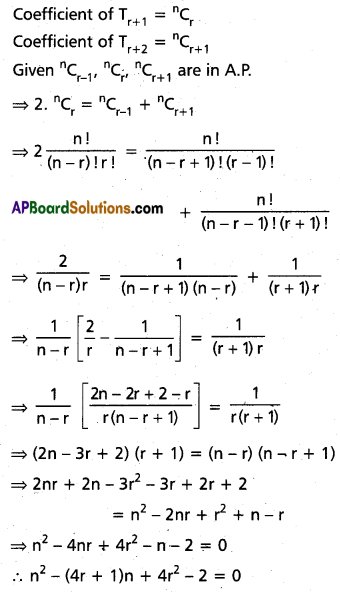
Question 5.
Find the sum of the coefficients of x32 and x-18 in the expansion of \(\left(2 x^3-\frac{3}{x^2}\right)^{14}\)
Solution:
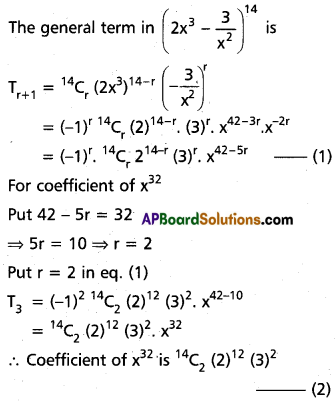
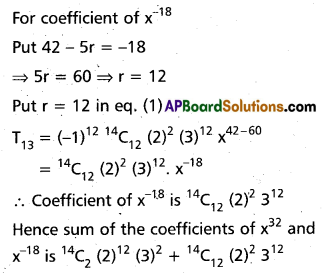
Question 6.
If P and Q are the sums of odd terms and the sum of even terms respectively in the expansion of (x + a)n then prove that
(i) P2 – Q2 = (x2 – a2)n
(ii) 4PQ = (x + a)2n – (x – a)2n
Solution:
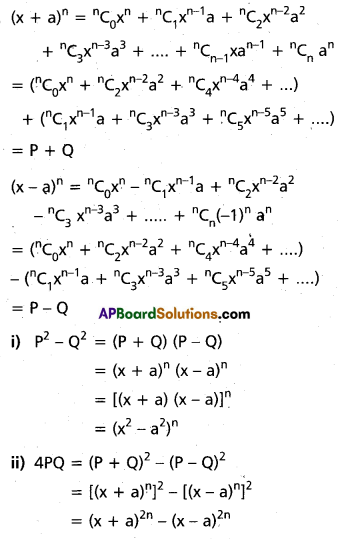
Question 7.
If the coefficients of 4 consecutive terms in the expansion of (1 + x)n are a1, a2, a3, a4 respectively, then show that \(\frac{a_1}{a_1+a_2}+\frac{a_3}{a_3+a_4}=\frac{2 a_2}{a_2+a_3}\)
Solution:
Given a1, a2, a3, a4 are the coefficients of 4 consecutive terms in (1 + x)n respectively.
Let a1 = nCr-1, a2 = nCr, a3 = nCr+1, a4 = nCr+2
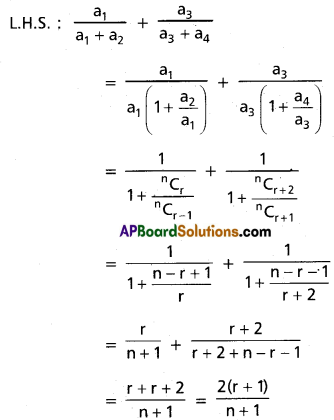
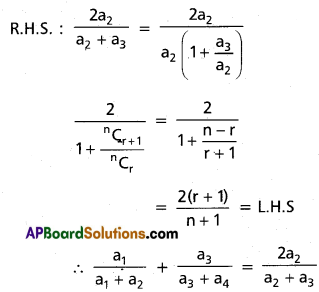

Question 8.
Prove that (2nC0)2 – (2nC1)2 + (2nC2)2 – (2nC3)2 + ……… + (2nC2n)2 = (-1)n 2nCn
Solution:
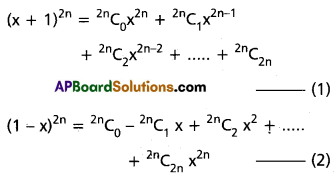
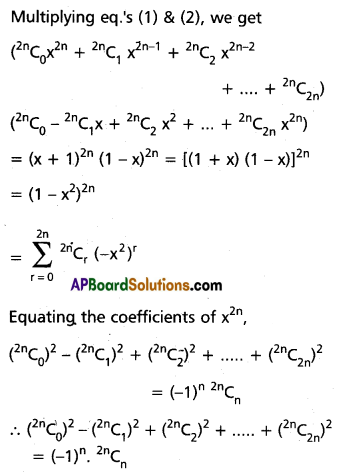
Question 9.
Prove that (C0 + C1)(C1 + C2)(C2 + C3) ………… (Cn-1 + Cn) = \(\frac{(n+1)^n}{n !}\) . C0 . C1 . C2 ……… Cn
Solution:
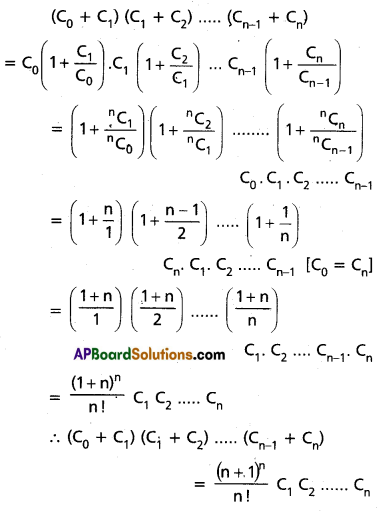
Question 10.
Find the term independent of x in \((1+3 x)^n\left(1+\frac{1}{3 x}\right)^n\)
Solution:
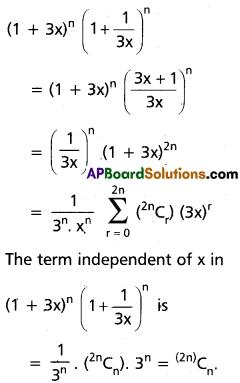
Question 11.
Show that the middle term in the expansion of (1 + x)2n is \(\frac{1.3 .5 \ldots(2 n-1)}{n !}(2 x)^n\)
Solution:
The expansion of (1 + x)2n contains (2n + 1) terms.
middle term = 2nCn xn
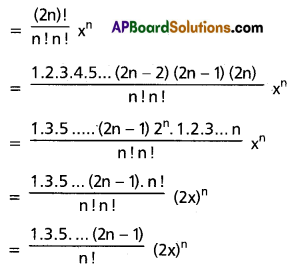
Question 12.
If (1 + 3x – 2x2)10 = a0 + a1x + a2x2 + …….. + a20 x20 then prove that
(i) a0 + a1 + a2 + ……… + a20 = 210
(ii) a0 – a1 + a2 – a3 + ……….. + a20 = 410
Solution:
(1 + 3x – 2x2)10 = a0 + a1x + a2x2 + ……… + a20 x20
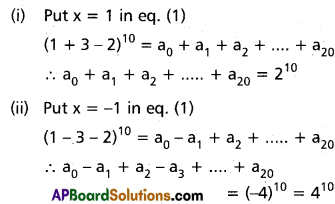
Question 13.
If (3√3 + 5)2n+1 = x and f = x – [x] where ([x] is the integral part of x), find the value of x.f.
Solution:


Question 14.
If R, n are positive integers, n is odd, 0 < F < 1 and if (5√5 + 11)n = R + F, then prove that
(i) R is an even integer and
(ii) (R + F) . F = 4n
Solution:
(i) Since R, n are positive integers, 0 < F < 1 and (5√5 + 11)n = R + F
Let (5√5 – 11)n = f
Now, 11 < 5√5 < 12
⇒ 0 < 5√5 – 11 < 1
⇒ 0 < (5√5 – 11)n < 1
⇒ 0 < f < 1

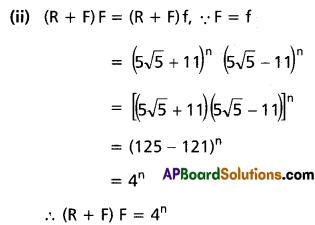
Question 15.
If I, n are positive integers, 0 < f < 1 and if (7 + 4√3 )n = I + f, then show that
(i) I is an odd integer and
(ii) (I + f) (1 – f) = 1
Solution:
Given I, n are positive integers and
(7 + 4√3)n = I + f, 0 < f < 1
Let 7 – 4√3 = F
Now 6 < 4√3 < 7
⇒ -6 > -4√3 > -7
⇒ 1 > 7 – 4√3 > 0
⇒ 0 < (7 – 4√3)n < 1
∴ 0 < F < 1
I + f + F = (7 + 4√3)n + (7 – 4√3)n
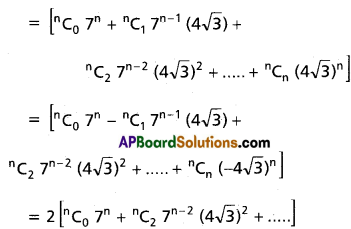
= 2k where k is an integer.
∴ I + f + F is an even integer.
⇒ f + F is an integer since I is an integer.
But 0 < f < 1 and 0 < F < 1
⇒ 0 < f + F < 2
∴ f + F = 1 ………..(1)
⇒ I + 1 is an even integer.
∴ I is an odd integer.
(I + f) (I – f) = (I + f) F …..[By (1)]
= (7 + 4√3)n (7 – 4√3)n
= [(7 + 4√3) (7 – 4√3)]n
= (49 – 48)n
= 1

Question 16.
If n is a positive integer, prove that \(\sum_{r=1}^n r^3\left(\frac{{ }^n C_r}{{ }^n C_{r-1}}\right)^2=\frac{(n)(n+1)^2(n+2)}{12}\)
Solution:
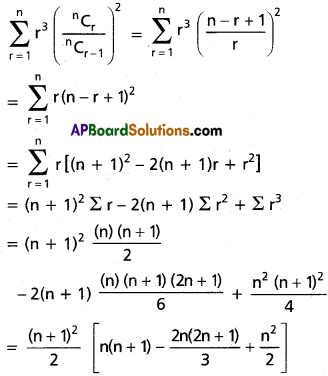
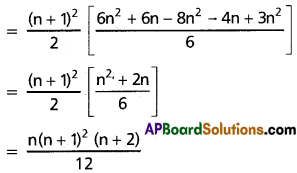
Question 17.
Find the number of irrational terms in the expansion of (51/6 + 21/8)100.
Solution:
General term
Tr+1 = \({ }^{100} C_r\left(5^{1 / 6}\right)^{100-r}\left(2^{1 / 8}\right)^r\) = \({ }^{100} C_r 5^{\frac{100-r}{6}} \cdot 2^{\frac{r}{8}}\)
\(\frac{100-r}{6}\) is an integer in the span
or 0 ≤ r ≤ 100 if r = 4, 10, 16, 22, 28, 34, 40, 46, 52, 58, 64, 70, 76, 82, 88, 94, 100
\(\frac{r}{8}\) is an integer in the span of 0 ≤ r ≤ 100
if r = 8, 16, 24, 32, 40, 48, 56, 64, 72, 80, 88, 96, \(\frac{100-r}{6}\), \(\frac{r}{8}\) both an integers
If r = 16, 40, 64, 88
∴ The number of rational terms in the expansion of (51/6 + 21/8)r is 4.
∴ The number of irrational terms in the expansion of (51/6 + 21/8)r is 101 – 4 = 97 terms.
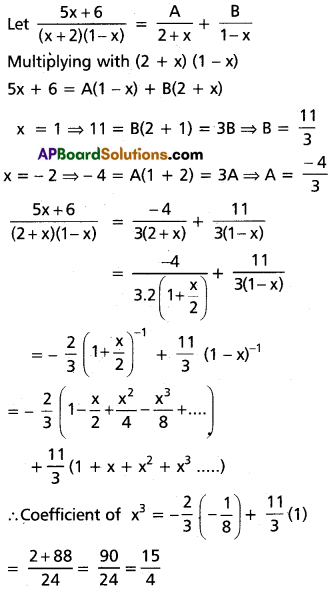
![]()
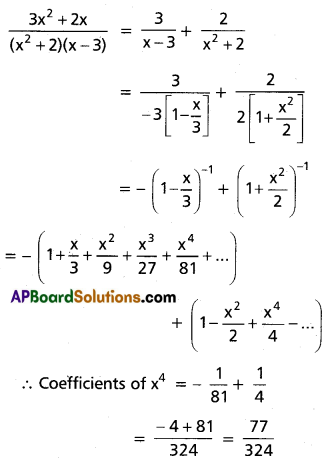
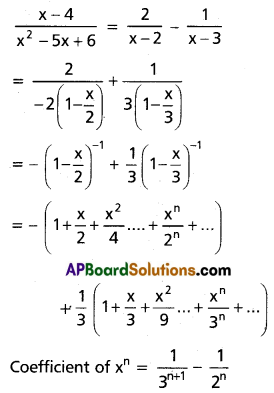
![]()
